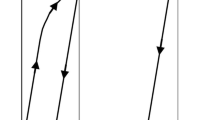Abstract
This work deals with the problem of springback compensation in sheet metal forming. Satisfactory results can be achieved by performing “die compensation”: the die is modified pretending to obtain a different configuration at the end of the punch stroke, but in order that the final piece coincides with the desired one after the deformation due to springback. Empirical die compensation has nowadays been replaced by numerical simulation, but the inverse problem that needs to be solved is non-trivial since the transformation from the modified geometry of the die and the final piece obtained from it implies a very complex FEM simulation. In this work we set the whole process of springback compensation on solid physical and mathematical grounds. An optimization algorithm based on the Gauss-Newton method is proposed to deliver automatic die compensation and its performance is investigated on some test cases.
Similar content being viewed by others
References
Hu SJ, Duncan JL, Marciniak Z (2005) Mechanics of sheet metal forming, 2nd edn. Elsevier, Amsterdam
Yuqi L, Ping H, Jincheng W (2002) Springback simulation and analysis of strong anisotropic sheet metals in U-channel bending process. Acta Mech Sin (Engl Ser) 18(3)
Campana F, Cortese L (2005) Sviluppo di un modello costitutivo per l’analisi FEM del ritorno elastico di componenti in lamiera sottile alto resistenziale. In: Associazione italiana per l’analisi delle sollecitazioni—XXXIV convegno nazionale
Hill R (1998) The mathematical theory of plasticity. Oxford University Press, Oxford
Mendelson A (1968) Plasticity: theory and application. Macmillan, London
Buranathiti T, Cao J (2004) An effective analytical model for springback prediction in straight flanging processes. Int J Mater Prod Technol 21(1–3):137–153
Maker BN, Zhu X (2000) Input parameters for metal forming simulation using LS-DYNA. Livermore Software Technology Corporation
Maker BN, Zhu X (2001) Input parameters for springback simulation using LS-DYNA. Livermore Software Technology Corporation
Maker BN, Zhu X (2003) A procedure for springback analysis using LS-DYNA. Livermore Software Technology Corporation
LS-DYNA theoretical manual (1998) Livermore Software Technology Corporation
Cai ZY, Li MZ, Chen XD (2006) Digitized die forming system for sheet metal and springback minimizing technique. Int J Adv Manuf Technol 28(11–12):1089–1096
Dan J, Lancheng W (2006) Direct generation of die surfaces from measured data points based on springback compensation. Int J Adv Manuf Technol 31(5–6):574–579
Lepadatu D, Habli R, Kobi A, Barreau A (2005) Optimisation of springback in bending processes using FEM simulation and response surface method. Int J Adv Manuf Technol 27(1–2):40–47
Cimolin F (2005) Metodologie di ottimizzazione della compensazione del ritorno elastico in un componente imbutito. Thesis, Dipartimento di Matematica, Politecnico di Torino
Canuto C, Cimolin F, Vadori V (2006) Compensazione del ritorno elastico in un componente imbutito. In: Associazione italiana per l’analisi delle sollecitazioni—XXXV convegno nazionale
Dutton T, Edwards R, Blowey A (2005) Tool design for a high strength steel side impact beam with springback compensation. In: 5th European LS-DYNA users conference
Meirovitch L (1986) Elements of vibration analysis, 2nd edn. McGraw-Hill, New York
OptiStruct 7.0 reference guide (2004) Altair Engineering, Inc
Altair HyperMesh TCL/TK macro training (2001) Altair Engineering, Inc
Nocedal J, Wright SJ (1999) Numerical optimization. Springer, Berlin
Kelley CT (1999) Iterative methods for optimization. SIAM, Philadelphia
Dennis JE, Schnabel RB (1983) Numerical methods for unconstrained optimization and nonlinear equations. Prentice-Hall, New York
TCL Standard Library. http://tcllib.sourceforge.net/
Powell MJD (1998) Direct search algorithms for optimization calculations. Acta Numer 7:287–336
Kolda TG (2005) Revisiting asynchronous parallel pattern search for nonlinear optimization. SIAM J Optim 16(2):563–586
Proud’Homme C, Rovas DV, Veroy K, Patera AT (2002) A mathematical and computational framework for reliable real-time solution of parametrized partial differential equations. Math Model Numer Anal 36(5):747–771
Rozza G (2005) On optimization, control and shape design for an arterial bypass. Int J Numer Methods Fluids 47(10–11):1411–1419
Gan W, Wagoner RH (2004) Die design method for sheet springback. Int J Mech Sci 46:1097–1113
Author information
Authors and Affiliations
Corresponding author
Rights and permissions
About this article
Cite this article
Cimolin, F., Vadori, R. & Canuto, C. Springback compensation in deep drawing applications. Meccanica 43, 101–113 (2008). https://doi.org/10.1007/s11012-008-9117-7
Accepted:
Published:
Issue Date:
DOI: https://doi.org/10.1007/s11012-008-9117-7



